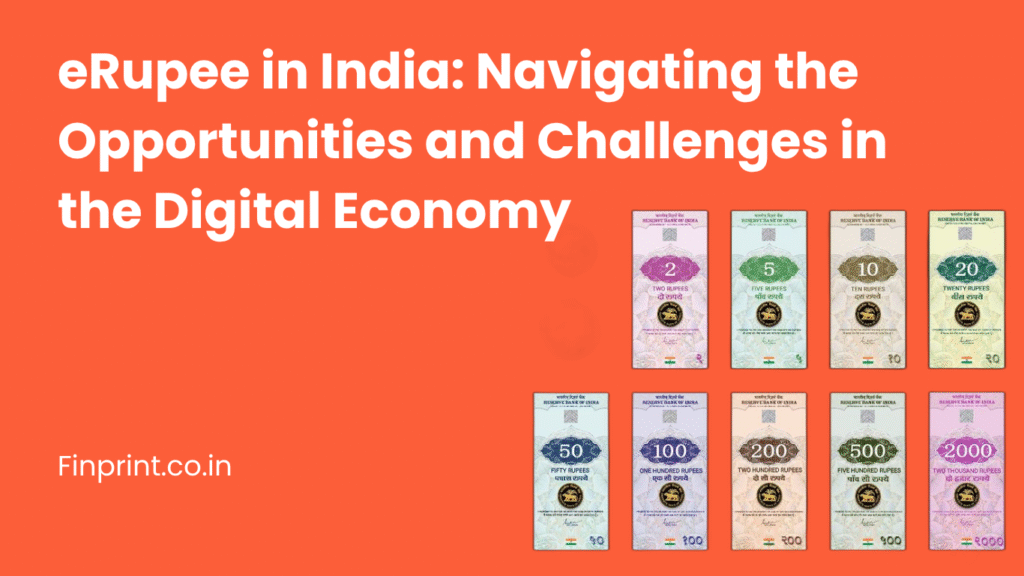EeIntroduction to eRupee in India

India, a country known for its technological advancements and rapid growth, is now embracing the era of digital currency. With the rise of digital payment platforms and the increasing penetration of smartphones, the adoption of digital currency has become a hot topic in the Indian economy. In this article, we will explore the opportunities and challenges that come with the adoption of digital currency in India, and discuss how businesses can navigate this new landscape.
The rise of eRupee in India
As of my last knowledge update in January 2022, there wasn’t a specific digital currency called “eRupee” that had been officially launched or widely recognized in India. However, discussions and explorations regarding the introduction of a Central Bank Digital Currency (CBDC) or a digital version of the Indian Rupee, sometimes referred to as the Digital Rupee or eRupee, were underway.
For the latest and most accurate information on the status of the eRupee or any developments related to the introduction of a digital currency in India, I recommend checking the Reserve Bank of India’s (RBI) official statements and recent news sources. The RBI has been actively researching and studying the feasibility of introducing a digital version of the Indian Rupee, but specific details may have evolved or been officially announced since my last update.
To stay informed, check the official announcements from the Reserve Bank of India or other authoritative sources regarding digital currency developments in India. It’s possible that there have been significant updates or changes in the landscape since my last knowledge update in January 2022.
Over the past decade, India has witnessed a significant shift towards digital payments. With the launch of the Unified Payments Interface (UPI) in 2016, the country saw a surge in digital transactions. The UPI enabled seamless and instant money transfers between banks, making digital payments accessible to a wider audience. This paved the way for the rise of digital currency in India.
One of the key drivers behind the adoption of digital currency in India is the government’s push for a cashless economy. Demonetization, which took place in 2016, aimed to curb the circulation of black money and promote digital transactions. This move encouraged the use of digital payment platforms and created a favorable environment for the growth of digital currency in India.
Benefits of digital currency in India
The adoption of digital currency in India brings a range of benefits for both individuals and businesses. Firstly, digital currency offers convenience and accessibility. With a smartphone and an internet connection, anyone can make digital transactions anytime, anywhere. This is especially beneficial for those living in remote areas where access to traditional banking services may be limited.
Secondly, digital currency promotes financial inclusion. In a country like India, where a significant portion of the population is unbanked or underbanked, digital currency provides an opportunity to bring these individuals into the formal financial system. By using digital payment platforms, people can now receive wages, pay bills, and access other financial services without the need for a traditional bank account.
Lastly, digital currency can help combat corruption and tax evasion. With digital transactions leaving a digital trail, it becomes harder for individuals and businesses to engage in illegal activities. This promotes transparency and accountability in the economy, ultimately leading to a more efficient and fair financial system.
Challenges in adopting digital currency in India
While the benefits of digital currency in India are evident, there are also several challenges that need to be addressed. Firstly, there is a lack of digital infrastructure in many parts of the country. Despite the increasing smartphone penetration, there are still areas with limited or no internet connectivity. This hinders the adoption of digital currency and restricts its reach.
Secondly, there is a lack of awareness and trust among the population. Many people in India are still not familiar with digital payment platforms and are hesitant to use them. This is especially true for the older generation who are more accustomed to traditional banking methods. Building trust and awareness among the population is crucial for the widespread adoption of digital currency.
Lastly, there are concerns around cybersecurity and data privacy. As digital transactions increase, so does the risk of cyber-attacks and data breaches. It is essential for businesses and individuals to take appropriate measures to protect their digital assets and personal information. Government regulations and policies on digital currency in India play a vital role in ensuring the security and privacy of digital transactions.
Government regulations and policies on digital currency in India
The Indian government has recognized the potential of digital currency and has taken several steps to regulate its usage. The Reserve Bank of India (RBI), the country’s central bank, has issued guidelines and regulations for digital payment platforms and cryptocurrencies. These regulations aim to ensure the stability and integrity of the financial system while promoting innovation and consumer protection.
One of the notable regulations is the Know Your Customer (KYC) norms, which require individuals to provide their identity and address proof while using digital payment platforms. This helps in preventing money laundering and other illicit activities. Additionally, the RBI has set limits on the amount of money that can be transacted digitally to prevent misuse and ensure the safety of users’ funds.
The government has also launched initiatives like the Digital India campaign, which aims to transform India into a digitally empowered society. This campaign focuses on improving digital infrastructure, promoting digital literacy, and increasing the usage of digital services across the country. These efforts, combined with the regulatory framework, create a favorable environment for the growth of digital currency in India.
Opportunities for businesses in the digital currency economy
The adoption of digital currency in India opens up a world of opportunities for businesses. One of the key areas where businesses can benefit is in the e-commerce sector. With the rise of digital payments, more people are now comfortable shopping online, creating a huge market for e-commerce businesses. By accepting digital currency as a payment method, businesses can tap into this growing customer base and increase their sales.
Another area of opportunity lies in financial technology (fintech) startups. These startups are revolutionizing the way financial services are delivered in India. By leveraging digital currency and payment platforms, fintech startups are providing innovative solutions for banking, lending, insurance, and other financial services. This not only improves the accessibility and affordability of financial services but also creates new business opportunities in the digital currency economy.
Furthermore, businesses can benefit from the increased transparency and efficiency that digital currency brings. With digital transactions leaving a digital trail, businesses can better track and analyze customer behavior, enabling them to make data-driven decisions. This helps in improving marketing strategies, enhancing customer experience, and ultimately increasing profitability.
Case studies of successful digital currency initiatives in India
To better understand the impact of digital currency in India, let’s take a look at some successful case studies. One such example is Paytm, a digital payment platform that has revolutionized the way Indians make payments. Paytm started as a mobile recharge platform but quickly expanded to include bill payments, peer-to-peer transfers, and online shopping. Today, Paytm has over 350 million registered users and is one of the leading digital payment platforms in India.
Another notable case study is the Aadhaar-enabled Payment System (AePS), a government initiative that aims to promote digital transactions in rural areas. AePS enables individuals to make payments using their Aadhaar number and biometric authentication. This has helped in bringing financial services to the unbanked population and has played a crucial role in promoting financial inclusion.
These case studies highlight the transformative power of digital currency in India and the opportunities it presents for businesses and individuals alike.
Tips for navigating the digital currency landscape in India
While the adoption of digital currency in India brings immense opportunities, navigating this new landscape can be challenging. Here are some tips to help businesses navigate the digital currency landscape in India:
- Understand the market: Before entering the digital currency space, it is essential to understand the market dynamics, consumer behavior, and regulatory landscape in India. Conduct thorough market research and stay updated with the latest trends and developments.
- Build trust and awareness: Educate your customers about the benefits of digital currency and address their concerns. Building trust among the population is crucial for the widespread adoption of digital currency. Invest in marketing campaigns and customer education programs to increase awareness.
- Ensure cybersecurity and data privacy: Protecting your digital assets and customer data should be a top priority. Implement robust cybersecurity measures, educate your employees about best practices, and comply with data protection regulations.
- Collaborate and innovate: Partner with fintech startups and other players in the digital currency ecosystem to leverage their expertise and technology. Embrace innovation and continuously evolve your business model to stay ahead of the competition.
Future prospects of digital currency in India
The future of digital currency in India looks promising. With the government’s push for a cashless economy and the increasing digital literacy among the population, the adoption of digital currency is expected to grow exponentially. As more businesses and individuals embrace digital payments, the digital currency ecosystem will expand, creating new opportunities for innovation and growth.
Furthermore, advancements in technology like blockchain and artificial intelligence are likely to revolutionize the digital currency landscape. These technologies have the potential to enhance security, increase efficiency, and reduce transaction costs. With the right regulations and policies in place, India can become a global leader in digital currency innovation.
Conclusion
Digital currency is transforming the way we transact and interact in the Indian economy. While there are challenges to overcome, the benefits of digital currency in India are immense. From promoting financial inclusion to improving transparency and efficiency, digital currency has the potential to reshape the Indian economy. By understanding the market, building trust, and embracing innovation, businesses can navigate the digital currency landscape and seize the opportunities that lie ahead. The future of digital currency in India is bright, and it is up to businesses and individuals to embrace this new era of digital transactions.



